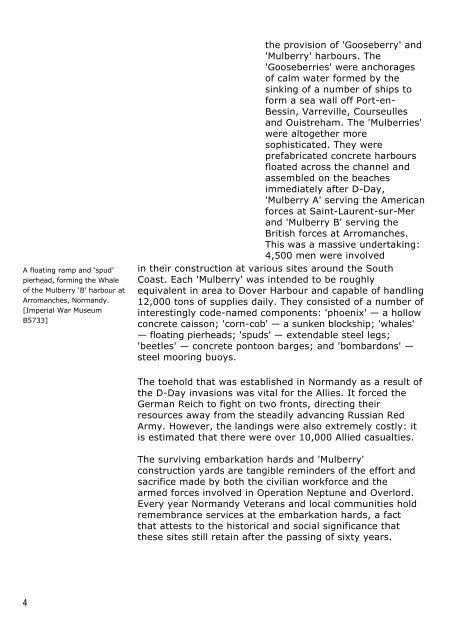by Roger J C Thomas - HELM
by Roger J C Thomas - HELM
by Roger J C Thomas - HELM
You also want an ePaper? Increase the reach of your titles
YUMPU automatically turns print PDFs into web optimized ePapers that Google loves.
A floating ramp and ‘spud’<br />
pierhead, forming the Whale<br />
of the Mulberry ‘B’ harbour at<br />
Arromanches, Normandy.<br />
[Imperial War Museum<br />
B5733]<br />
4<br />
the provision of 'Gooseberry' and<br />
'Mulberry' harbours. The<br />
'Gooseberries' were anchorages<br />
of calm water formed <strong>by</strong> the<br />
sinking of a number of ships to<br />
form a sea wall off Port-en-<br />
Bessin, Varreville, Courseulles<br />
and Ouistreham. The 'Mulberries'<br />
were altogether more<br />
sophisticated. They were<br />
prefabricated concrete harbours<br />
floated across the channel and<br />
assembled on the beaches<br />
immediately after D-Day,<br />
'Mulberry A' serving the American<br />
forces at Saint-Laurent-sur-Mer<br />
and 'Mulberry B' serving the<br />
British forces at Arromanches.<br />
This was a massive undertaking:<br />
4,500 men were involved<br />
in their construction at various sites around the South<br />
Coast. Each 'Mulberry' was intended to be roughly<br />
equivalent in area to Dover Harbour and capable of handling<br />
12,000 tons of supplies daily. They consisted of a number of<br />
interestingly code-named components: 'phoenix' — a hollow<br />
concrete caisson; 'corn-cob' — a sunken blockship; 'whales'<br />
— floating pierheads; 'spuds' — extendable steel legs;<br />
'beetles' — concrete pontoon barges; and 'bombardons' —<br />
steel mooring buoys.<br />
The toehold that was established in Normandy as a result of<br />
the D-Day invasions was vital for the Allies. It forced the<br />
German Reich to fight on two fronts, directing their<br />
resources away from the steadily advancing Russian Red<br />
Army. However, the landings were also extremely costly: it<br />
is estimated that there were over 10,000 Allied casualties.<br />
The surviving embarkation hards and 'Mulberry'<br />
construction yards are tangible reminders of the effort and<br />
sacrifice made <strong>by</strong> both the civilian workforce and the<br />
armed forces involved in Operation Neptune and Overlord.<br />
Every year Normandy Veterans and local communities hold<br />
remembrance services at the embarkation hards, a fact<br />
that attests to the historical and social significance that<br />
these sites still retain after the passing of sixty years.










